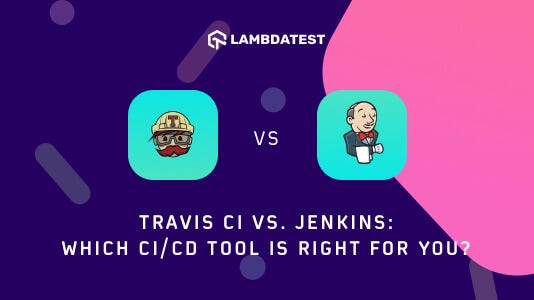Travis CI and Jenkins are both popular CI/CD tools and were launched in the same year i.e. 2011. As of July 2020, Jenkins has been the more obvious choice as CI/CD tool with 15.9k stars & 6.3k forks, in comparison to TravisCI which has 8k stars & 756 forks. However, these numbers alone don’t imply which CI/CD tool is more suitable for your upcoming or existing project. Jenkins is an open-source & Travis CI is free for open-source projects.
As a DevOps professional, you need to evaluate these tools based on your budget, project requirements, and other data points. This is why we take a deep dive into Travis CI vs Jenkin’s comparison to help you decide the right CI/CD tool for your project requirements.
Without further ado, let’s get started.
What is Jenkins?
Jenkins is a popular open-source CI/CD tool that is in usage for a long time. The tool is written entirely in Java. Jenkins has a powerful set of features that can be used to build, test, and integrate changes in a project.

It is the go-to choice for startups as it is free to use, supports a wide range of plugins, and is backed by a vibrant community. Developers get the chance to set up a CI/CD environment in Jenkins. Jenkins is available for a wide range of platforms — Windows, macOS, and various flavors of Unix (i.e. Ubuntu, OpenSUSE, and more).
Another major of Jenkins is its extensibility with plugins. Like other open-source projects, Jenkins maintains two release lines — weekly and LTS (Long Term Support). At the time of this article, the latest version of Jenkins (LTS) was 2.235.1.
Salient features of Jenkins
- Open source and free for use.
- Extensive plugin ecosystem.
- Vibrant community.
- Supports parallel execution.
- Ease to set up.
- Offers REST API.
- Can be configured using Jenkinsfile.
What is Travis CI?
Amongst all the CI/CD tools, Travis CI is undoubtedly one of the most popular choices. Initially, it was created for open source projects but with time, the tool has also migrated to close source projects. Like Jenkins, Travis CI is also one of the early players in the CI/CD tools market.
The tool is written in Ruby and is developed & maintained by the Travis CI community. Travis CI was earlier available only for GitHub hosted projects but now it also supports Bitbucket hosted projects.

It is available for Linux, macOS, and Windows (early stage) operating systems. Travis CI is free of charge for every open-source project. For using Travis CI, you should have an account on GitHub or Bitbucket. There is no installation required and you can get started by simply signing up and adding a project.
Salient features of Travis CI
- Free for testing open-source applications.
- Available for Continuous Delivery (CD) and Continuous Integration (CI).
- Available for macOS, Linux, Windows (early stages).
- Supports around 30 different programming languages like Ruby, Perl, Python, Scala, etc.
- Can be configured after adding .travis.yml file (i.e. YAML format text file).
- Supports integration with external tools.
- Supports build matrix feature to accelerate the project execution.
Let’s start with a detailed Travis CI vs Jenkins face-off by evaluating it from perspectives of usability, support, and more.
Travis CI vs Jenkins — Detailed Showdown
Here are some of the features used for Travis CI vs Jenkins comparison:
Setup and Installation
Jenkins is a self-contained Java program that runs seamlessly out of the box. In total, three major steps are involved if Java and Tomcat server is pre-installed. Jenkins is available for Windows, Unix, and macOS platforms.
Jenkins can be combined with Docker to bring more speed and consistency to the automation tasks. Jenkins can run as a servlet in Java containers like GlassFish and Apache Tomcat.
Using the Travis CI tool with a cloud-hosted code repository does not require any installation. However, the following prerequisites have to be met:
- An account on GitHub or Bitbucket
- Owner permissions for the project hosted on the preferred platform (i.e. GitHub or Bitbucket)
For getting started with Travis CI with GitHub, the developer needs to sign up with GitHub on Travis. Enable the repository for testing from Travis Settings Page and add .travis.yml (YAML text file) to the root directory. Further details about the installation of Travis CI using GitHub and Bitbucket are available here.
The setup and installation process of Jenkins is simple, as few steps are required in the installation. Travis CI is one of the preferred tools if you are using GitHub or Bitbucket, as it integrates with the respective platforms. It automatically runs the test suites when any change is pushed to the repository.
#travis-ci #automation #cicd #devops #jenkins
